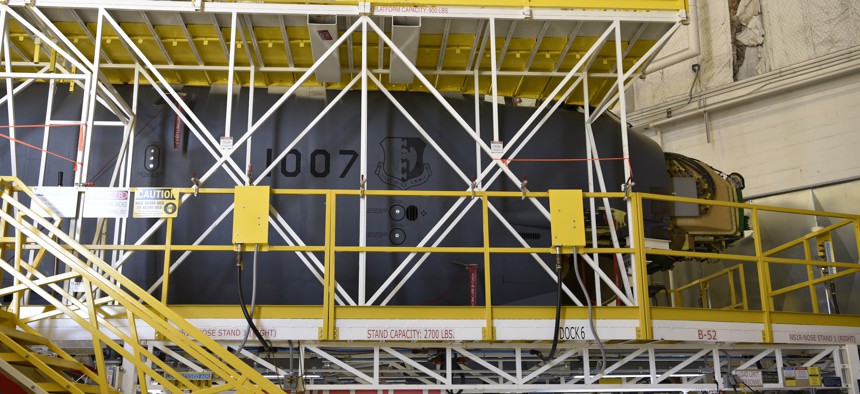
A B-52H bomber nick named “Ghost Rider” undergoes routine programmed depot maintenance at the Oklahoma City Air Logistics Complex Nov. 20, 2020. Ron Mullan
Defense Business Brief: New engines should never leave B-52 wing; AUSA next week; New Gulfstream jets; and more.
The new Rolls-Royce engines expected to power the U.S. Air Force’s Cold War-era B-52 bomber to its 100th birthday will never have to come off of the Stratofortress’ wing for maintenance.
That detail was revealed by Tom Bell, Rolls-Royce president of Defence and chairman and CEO of Rolls-Royce North America, during the Global Business Briefing on Thursday.
“We project that the engines we install on the B-52 will never come off [the] wing,” Bell said.
There are some caveats: if debris—maybe a rock or a bird—is sucked into an engine or there’s battle damage. But still, it’s a big deal. B-52 engines are typically removed for months-long “depot” maintenance every four years.
Since none of the eight Rolls-Royce F130 engines on the B-52 will be removed during these overhaul periods, it “drives the maintenance burden down and how that drives the sustainment burden down,” Bell said.
Here’s some more from our friends at Air Force Magazine about how Rolls-Royce is using digital engineering to develop the new B-52 engines.
If you want to watch my entire interview with Tom Bell and (coincidentally enough) Bell CEO Mitch Snyder, click here. We’ll be having more discussions with defense industry CEOs as part of our Global Business Briefing event series in coming months.
The Association of the U.S. Army’s annual conference is scheduled for next week in Washington. “The auto show on steroids,” as Defense One Editor Kevin Baron likes to call it, is expected to draw more than 33,000 attendees and 650 exhibitors from more than 80 countries, according to the event organizer.
Former Google boss Eric Schmidt has launched the Special Competitive Studies Project, “a new initiative that will make recommendations to strengthen America’s long-term global competitiveness for a future where artificial intelligence and other emerging technologies reshape our national security, economy, and society.” Schmidt and former Deputy Defense Secretary Robert Work co-chaired the National Security Commission on Artificial Intelligence, which recently disbanded. The group’s board will include Work; Nadia Schadlow, a former deputy national security advisor for strategy; Michèle Flournoy, a former defense undersecretary for policy; and former Rep. Mac Thornberry. Ylli Bajraktari, a top aide to Work at the Pentagon, has been named CEO.
Collins Aerospace has opened an Army Aviation-focused “Customer Experience Center” in Huntsville, Alabama. “With its proximity to Redstone Arsenal, the new facility will allow Collins to work closely with the service and industry partners on critical Army Aviation initiatives, including Future Vertical Lift and enduring fleet modernization, while providing configurability to evolve with the Army’s needs,” the company said. Here’s a video inside.
Weekend reading: The Congressional Research Service’s Ron O'Rourke has a new backgrounder about the Navy’s unmanned surface and undersea vehicles.
General Dynamics’ Gulfstream unveiled two two new business jets, the G800 and G400. The G800, which replaces the G650, will be “the longest-range aircraft in Gulfstream history” — able to fly for 8,00 nautical miles. The G400 is “the first new entrant to the large-cabin class in more than a decade.” Militaries around the world fly Gulfstream jets for VIP transportation and intelligence missions. The popular G-550, which Gulfstream stopped building earlier this year, are currently being converted into U.S. Air Force intelligence planes by L-3Harris.
 From Defense One
From Defense One
Bell Picks Rolls-Royce Engine for V-280 Valor in Army Black Hawk Replacement Contest // Marcus Weisgerber
The move dramatically increases the horsepower of the V-280 over the General Electric engines it uses today.
Lockheed Opens New Hypersonic Weapons Factory In Alabama // Marcus Weisgerber
The manufacturing plant is the third digital factory opened by the world's largest defense contractor this year.
How Well Can AI Pick Targets From Satellite Photos? Army Test Aims to Find Out // Patrick Tucker
The Scarlet Dragon exercise is evaluating ways the service might put new tools to use in the very near term.
Pentagon Begins 'Continuous Vetting' of All Troops for Insider Threats, Extremism; Social Media May Come Next // Patrick Tucker
Automatic alerts will flag records or activities of concern among all Defense Department personnel.
New DOD Climate Plan: Adjust Ops, Training, Gear for Extreme Weather // Tara Copp
Virtual exercises will help when wildfires rage; equipment will be tested for health effects in intense heat and cold.
More Than Just Subs: AUKUS Will Change Pacific Air Ops as Well // Col. Douglas D. Jackson
For example, U.S. air forces will be able to practice and refine the burgeoning agile combat employment, or ACE, concept.
NSA Cyber Chief Spells Out Near-Term Priorities // Brandi Vincent
Ransomware is a top concern, but the agency is also looking ahead to defending networked weapons and post-quantum encryption.
Is This the Next US Military Base in Europe? // Jacqueline Feldscher
Lithuania built Camp Herkus to woo a permanent contingent of American troops. But the Biden administration is far from convinced.





